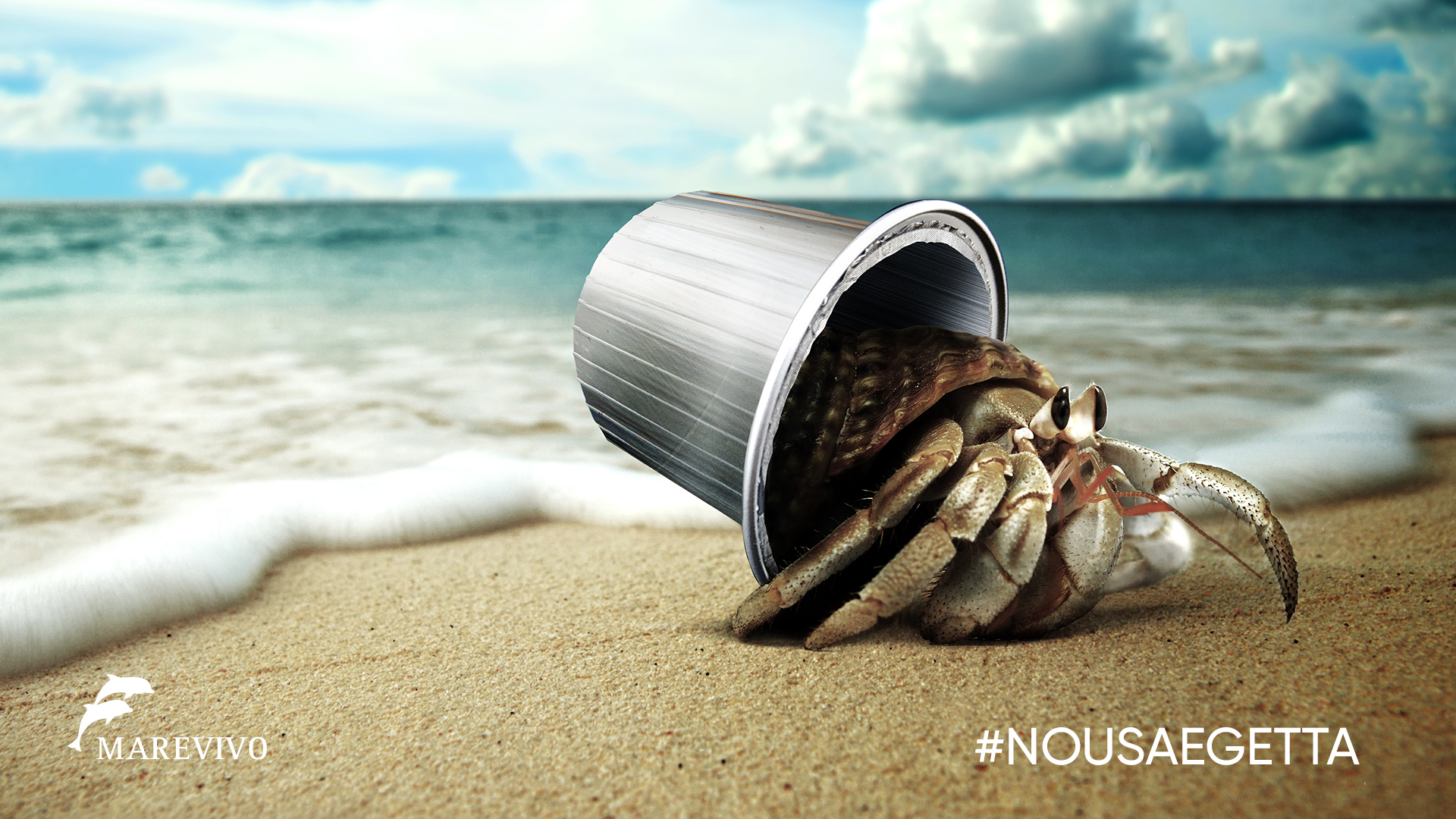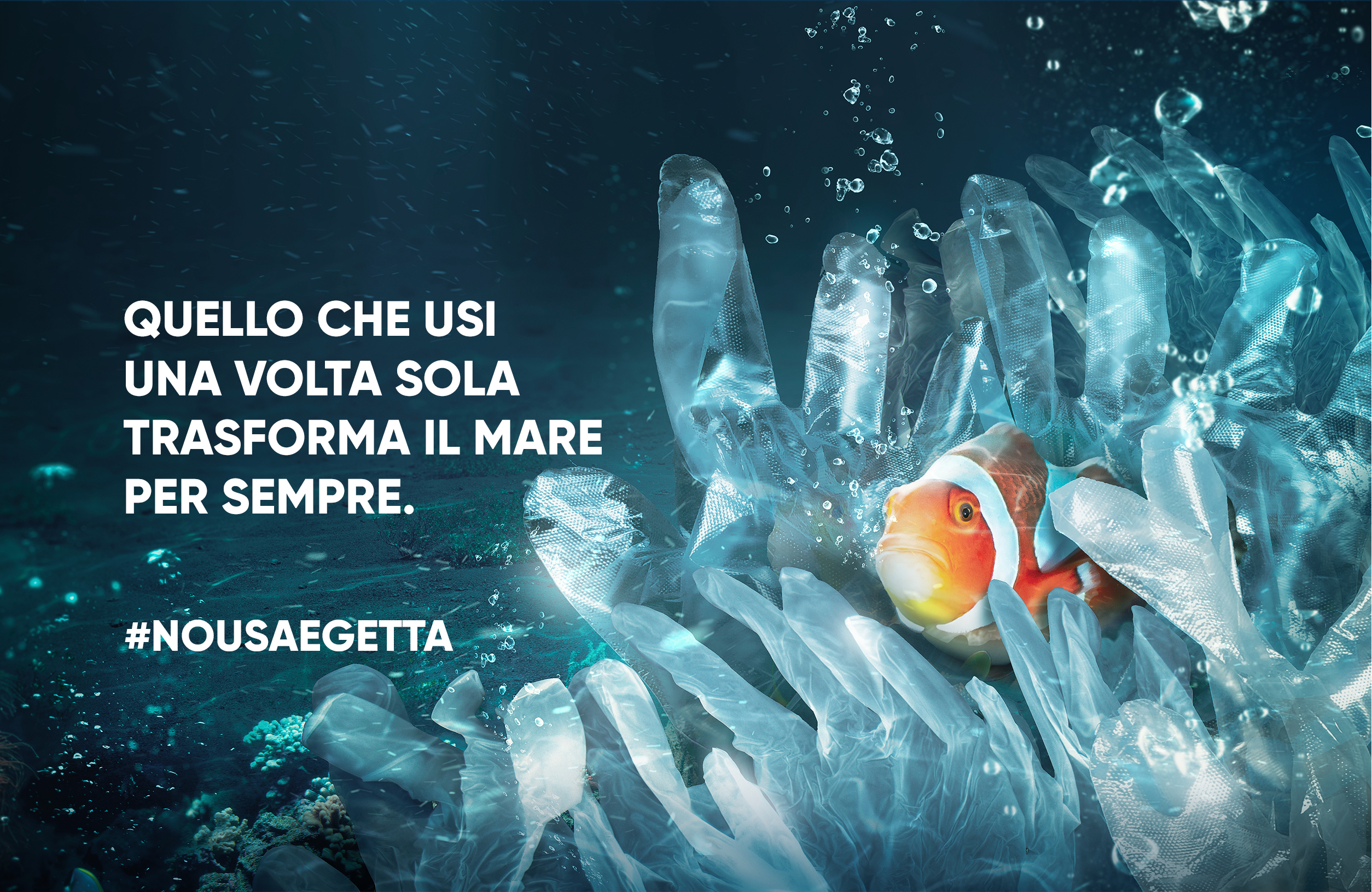MAREVIVO’S CAMPAIGN AGAINST DISPOSABLES TO SUPPORT THE SEA AND THE ENVIRONMENT
The problem
The pollution of oceans has become one of the most urgent environmental problems to solve.
For every minute that goes by, the equivalent of a camion of waste ends up in the sea and oceans of the world.
300 milion
tons of plastic are produced annually in the world. Of these, 10 million end up being poured into the oceans.
80%
of the waste found in the oceans is plastic waste, 90 percent of which is disposable items such as cutlery, glasses, cotton swabs, and balloon sticks
In 2040
there could be about 600 million tons of plastic spilled into the waters of our seas. That’s like finding 50 kilograms of plastic on every single meter of coastline around the world
EMERGENCY USE AND DISPOSABLE plastics make up 50 percent of all plastics produced each year
Reduce the consumption of disposable plastic and support Marevivo
Quantities are unfortunately bound to increase in this time of health emergencies.
In an effort to protect ourselves as much as possible from COVID-19, we are witnessing an overbearing return of disposable materials (gloves, masks, disposable cups, and containers, plasticized packaging, etc.), a mode mistakenly intended as a safety panacea and which in reality produces tons of waste making the already alarming level of pollution much worse.
Immediate action is needed to curb the problem by reducing the presence of plastic in the environment, undertaking more sustainable initiatives, reusing what is reusable, preferring biodegradable materials and properly disposing of anything that is not. One of the goals to be achieved is to improve waste management and recycling systems through design that takes into account the short life of packaging and less production of disposable plastic that we could certainly do without.
Let's make some clearance
RECYCLABILITY
Recyclable materials are all wastes that can be reused to produce new objects equal to waste (glass, paper) or used to produce new materials (wood, textiles).
Materials that can be recycled are wood, glass, paper and cardboard, textiles, tires, aluminum, steel, plastics, and organic waste.

THE PRIMACY TO ALUMINUM, 100% RECYCLABLE
Recycling aluminum is good for the environment and the economy, and, once recovered, it then becomes cars, coffee makers, glasses, and bicycles…
Aluminum, like all metallic materials, is easily recyclable by melting, and while in the case of other metals, recovery is important, for aluminum, this practice is essential because it is infinitely recyclable, 100 percent, and using only 5 percent of the electricity needed to produce the primary one.
COMPOSTABILITY
Compostable means convertible into compost, that is, natural fertilizer. The compostability of a package or material is its ability to be organically recycled along with the wet fraction of waste through industrial composting, a biological decomposition process that takes place under controlled conditions. At the end of the composting process is compost, a biologically stable, inert, and odorless substance rich in humus, active microbial flora, and trace elements, used to restore nutrients and organic matter to soils. A biodegradable and compostable manufactured product, according to the European standard UNI EN 13432, at the end of the composting process does not release harmful substances that alter the quality of compost, disintegrates, and turns into compost within a maximum of 90 days. Packaging and compostable products certified to the above standard by the various certification bodies can then be collected with the organic waste fraction and sent for industrial composting.
Properly treated, a certified compostable product is quickly transformed into a resource.
Remember that organic wastes, biodegradable plastics and compostables are thrown in the organic trash according to the directions of your municipality.


BIOPLASTIC: A BIODEGRADABLE AND COMPOSTABLE MATERIAL
Bioplastic is an alternative to traditional plastic. Its production requires elements such as corn, wheat, beet, or other grains. The result is a product similar to plastic but biodegradable and compostable.
Unlike traditional plastic, totally derived from petroleum and is not biodegradable, which shreds but is never disposed of, bioplastic materials, take only a few months to be biodegraded and do not make the soil sterile and allow them to be made into fertilizer manure after use.
The fact that bioplastics are biodegradable does NOT mean that they can be thrown into the environment or the sea-in fact, they only biodegrade under certain conditions.
RENEWABILITY
It concerns the origin of a product and in particular the characteristic of those raw materials – primarily of plant and animal origin – to regenerate in a short time (plants, trees, their derivatives, and waste), as opposed to raw materials from fossil sources (petroleum).
A material is therefore renewable if its raw materials are derived from plant or animal sources. Such plant or animal sources are characterized by the presence of carbon that is defined as recent as it comes from photosynthesis or assimilation phenomena, as opposed to the carbon in petroleum which is defined as fossil carbon. Therefore, an effective way to measure the degree of “renewability” of a material, that is, the presence of raw materials derived from plant (or animal) sources, is to measure the amount of recent carbon in it.


THE GROCERY BAG: PLASTIC OR BIODEGRADABLE COMPOSTABLE
A little more info on this largely used object, often thrown in the wrong way
Dispersed plastic bags in the environment have done incalculable damage to the planet in terms of pollution, but at the same time, the use of inadequate bags for the collection of wet waste nullifies the efforts sustained by agencies and citizens to sort waste. In our daily use, a frequent misunderstanding that leads to improper disposal concerns the grocery bags we often use for the wet waste collection bin.
While we have now learned to throw only food and organic waste into the wet waste bin, which can rightfully enter the composting process, we need to be careful to choose only between compostable, compostable bioplastic, or paper bags to collect this waste.
Compostability codes
Check the bag for compostability codes according to UNIENI 13432. The certifications that guarantee the respect of this regulation are, instead, essentially three: CIC, VINCOTTE, and DIN CERTCO. Finding one of the three symbols imprinted on the bag is the equivalent of being certain that you are using an item that complies with the law, is environmentally friendly, and complies with the rules for the delivery of wet waste.
Alternatives to plastic bags
Favour a reusable bag, a compostable or biodegradable shopping bag, or a bioplastic bag, to a plastic grocery bag, because conventional plastic bags or food wrappers remain in the environment for hundreds of years if mistakenly disposed of.
Where do you throw it?
Remember that compostable bags always have to be thrown in the wet bin.
Use reusable materials, if you can’t pay attention to symbols

What you can do

Non abbandonare
niente nell’ambiente

Substitute disposable material for reusable material

If you really can’t do without disposable material, favor biodegradable and compostable material

Frequently wash your hands instead of single-use gloves

Each municipality has its own rules on garbage collection, so it is important to inform yourself and follow the directions for proper disposal







